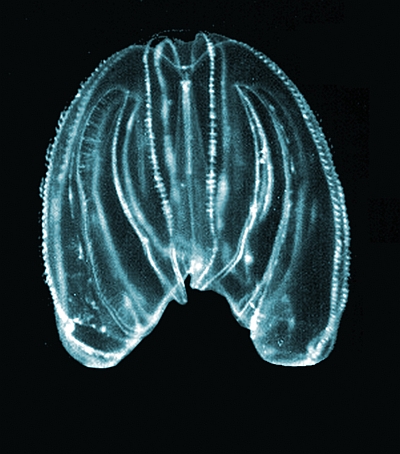Marine and coastal ecosystems
The sea is home to a great variety of marine communities and species. These plants and animals in the Black Sea form a complex food chain. Marine plants, dominated by phytoplankton or micro algae, provide the primary source of food to the oceans and are known as primary producers, the first level of the food chain. They provide food to the minute herbivorous animals predominating in the zooplankton, the primary consumers. They are food for the larger carnivorous zooplankton or fishes. Fishes are the food source for consumers further up the food chain – larger fishes, birds, marine mammals and humans. At all levels of the food chain the energy passed from one level on to the next is between 10 and 20 % of the original, therefore disturbance of even one level can cause significant impact on the whole system.
Fishes are the food source for consumers further up the food chain – larger fishes, birds, marine mammals and humans. At all levels of the food chain the energy passed from one level on to the next is between 10 and 20 % of the original, therefore disturbance of even one level can cause significant impact on the whole system.Phytoplankton consists of miniature free-floating algae that drift in the upper surface layers of the sea where there is enough sunlight to use in the process of photosynthesis supporting their basic life functions. Increased nutrients loads in the coastal zone over the recent decades have resulted in a shift in the ratio of species with a relative increase in the numbers of dinoflagellates and the appearance of several new phytoplankton species. Zooplankton or the free-living marine animals include marine larvae but not adult fishes and some other adult marine species. The zooplankton community is particularly sensitive to changes in the structure of its populations like the introduction to the Black Sea of an exotic species, the jellyfish Mnemiopsis Leidyi.
The seabed or benthic communities are comparatively well studied, the most abundant being arthropods and worms. Another foreign ‘invader’ to the Black Sea, the snail Rapana Thomasiana, is often harvested by the illegal method of bottom trawling. This is harmful to the seabed because the trawls plough through it and destroy the benthic communities.
Fish is one of the most important Black Sea resources. Its use however is not sustainable and the fish stocks are on the decrease. In the 1960-s there were about 26 commercial fish species in the Black Sea, now there are five or six.
The marine mammals in the Black Sea are represented by the dolphin family. The most common species are the common dolphin, the bottle-nosed dolphin and the harbor porpoise. All dolphin species are protected and dolphin catching in banned. The monk seal is believed to have left the sea as a whole, as there are no scientific data of recent sightings. There are many important bird areas all along the Black Sea coast. They are breeding and wintering sites for geese, ducks, swans, shelducks, warblers, wheathers, storks, gulls and raptors. A considerable number of wetlands – swamps, marshes and lakes, are of special significance for the wintering of resident and migrant birds and are therefore defined as Ramsar Sites. Other important European bird areas still remain unprotected. The number and scope of marine protected areas in the Black Sea is still very small.


